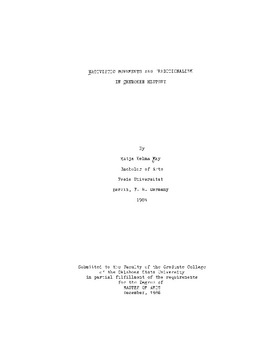| dc.contributor.advisor | Baird, W. David | |
| dc.contributor.author | May, Katja Helma | |
| dc.date.accessioned | 2016-01-12T16:53:21Z | |
| dc.date.available | 2016-01-12T16:53:21Z | |
| dc.date.issued | 1986-12-01 | |
| dc.identifier.uri | https://hdl.handle.net/11244/24586 | |
| dc.description.abstract | In the recent tradition of "New Indian History" which developed in the 1970s and 1980s, this study centers on the Indians as actors and "makers" of history and seeks to reinterpretate "old" histories. Heretofore Cherokee history has been written from the perspective that the "disappearance" of the Indian seemed to call for an explanation if not justification. More recently, however, ethnohistorians have discovered that the cultural processes involved in the so-called "disappearance" requires a more careful investigation. It now appears that Cherokee culture did not simply disappear but has adapted and later resurfaced in different forms. Nativistic movements have preserved Cherokee culture in ways that made the culture meaningful in particular historical contexts. In the early period of Cherokee-American contact, the Chickamaugans and similar emigrant groups represented a separatist, even militant, nativistic movement. During the early nineteenth century nativism expressed itself in "nationalism" as in White Path's cautious "rebellion" against changes that were perceived as too fundamental and in the tribe's organization of its removal from the East. The use of the Cherokee language in speech and writing was also a nativistic movement. In the nineteenth century Christian fundamentalism and Cherokee traditionalism were almost indistinguishable. Indeed nativistic leadership emerged from both movements. Taskegidi's (Jesse Bushyhead) "temper ance movei ment" instilled a sense of self-confidence in the Cherokee people after the removal, where the Keetoowah Society, of "ancient origin," played a significant role during and after the Civil War as self-acclaimed "defenders of the nation." The late nineteenth and twentieth centuries saw the emergence of other nativistic organizations that restored and perpetuated a vital and meaningful Cherokee culture despite allotment and dissolution of formal tribal government. Today Cherokee culture greatly enriches American society. | |
| dc.format | application/pdf | |
| dc.language | en_US | |
| dc.publisher | Oklahoma State University | |
| dc.rights | Copyright is held by the author who has granted the Oklahoma State University Library the non-exclusive right to share this material in its institutional repository. Contact Digital Library Services at lib-dls@okstate.edu or 405-744-9161 for the permission policy on the use, reproduction or distribution of this material. | |
| dc.title | Nativistic Movements and Traditionalism in Cherokee History | |
| dc.type | text | |
| dc.contributor.committeeMember | Smith, Michael M. | |
| dc.contributor.committeeMember | Brown, Donald N. | |
| osu.filename | Thesis-1986-M466n.pdf | |
| osu.accesstype | Open Access | |
| dc.description.department | History | |
| dc.type.genre | Thesis | |
